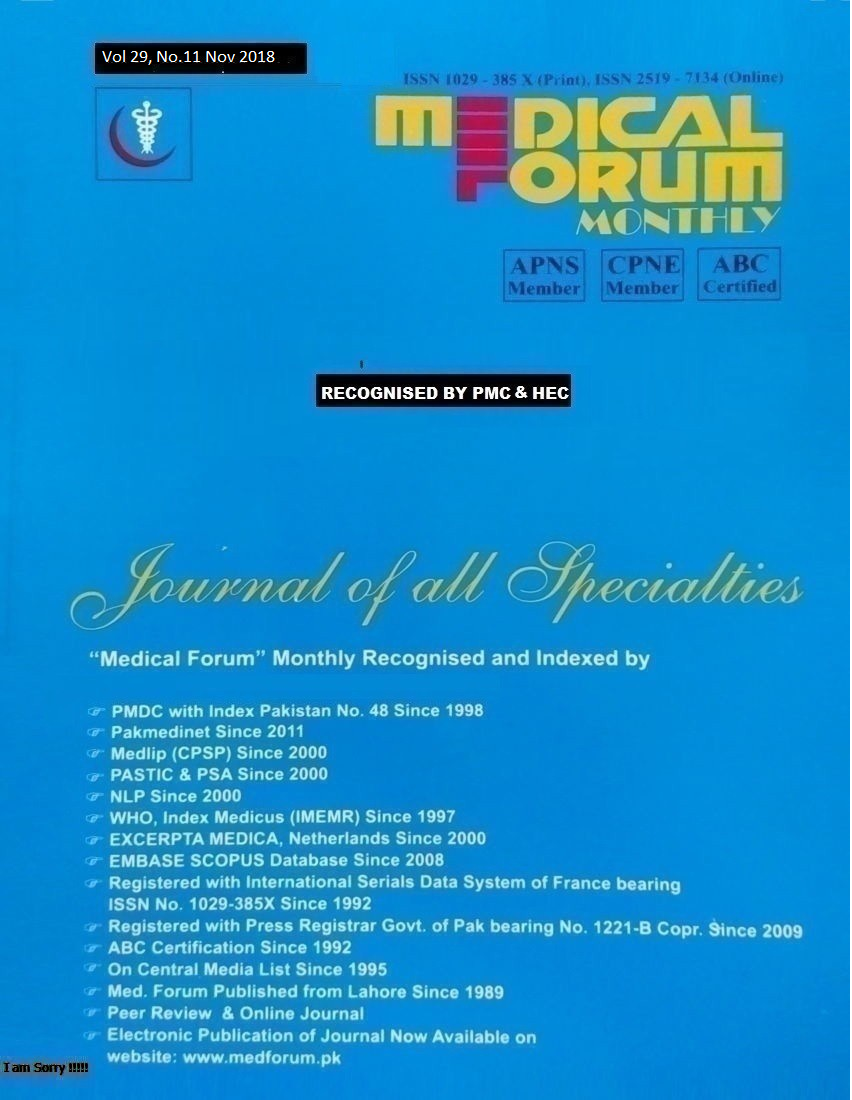
5. Frequency of Thrombotic Microangiopathy in Patients with Pregnancy Related Acute Kidney Injury
Fazal Mohammad1, Fozia Mohammad Bakhsh2 and Syed Mohkam1
ABSTRACT
Objective: To determine the Frequency of thrombotic micro-angiopathy in patients with pregnancy related acute kidney injury.
Study Design: Cross-sectional study.
Place and Duration of study: This study was conducted out at Department of Nephrology, Baluchistan Institute of Nephro-Urology, and Department of Obs and Gynae, BMCH Quetta from July 2016 to December 2017.
Material and Methods: A heterogeneous disease called Pregnancy-related acute kidney injury (P-AKI that occurs due to a large number of important etiologies. Although a rare but a fatal cause of P-AKI ispregnancy associated Thrombotic microangiopathy (TMA), with very poor consequence. Patient survival pregnancy and kidney outcome is dependent on early diagnosis and prompt treatment. The two most common disorder of thrombotic microangiopathies (TMA) are TTP (thrombotic thrombocytopenic purpura) and HUS (hemolytic uremic syndrome). In this study we would determine the frequency of thrombotic microangiopathy in patient with pregnancy related acute kidney injury. Among the patients admitted in department of gynecology and obstetrics during this period, who developed AKI, MAHA and unexplained thrombocytopenia were enrolled. Modified Jaffe’s technique was used to measure serum creatinine whereas Modification of Diet in Renal Disease (MDRD) equation was used to measure glomerular filtration rate. Acute Kidney Injury was defined as when the urine output decreased to less than 400 mL for more than 6 h or serum creatinine increased about 1.5 times from the baseline or both. Thrombotic microangiopathy was further classified into TTP and a HUS. ADAMS-TS-13 levels were sent. . Data was collected on predesigned Performa. Non-probability consecutive sampling technique was used for sample collection. After accomplishment of data of required sample, a statistics was established on SPSS version 22.0 for data analysis. For continuous variables such as age the mean, median and standard deviation was calculated. For qualitative variables Pearson Chi- square test (χ2) was applied whereas t-test was applied for all continuous variables. P-value < 0.05 considered as significant.
Results: 2763 patients were admitted in department of Gynecology, 221patients (8%) were diagnosed as pregnancy related AKI (P-AKI).among them 26 patients (11%) had pregnancy related thrombotic microangiopathy (P-TMA) as a cause of AKI. 19 patients were having TTP and 7 had HUS.15 Patients were nulliparous while 11 were multiparous. The mean age was 29.5±3.8 years. Most of TTP patients 15/19 presented antepartum while 4/19 postpartum. HUS developed in all patients in postpartum period.50 % of the patients with TTP required dialysis initially but only 10 % developed ESRD. In HUS group 90 % required dialysis initially and 80 % remained dialysis dependent .thrombocytopenia was more severe in TTP group while renal failure in HUS.
Conclusion: The spectrum of thrombotic microangiopathies (TMA) during pregnancy has very complex presentation .Although very difficult to differentiate from acute fatty liver of pregnancy and HEELP syndrome yet is very necessary as each of them have entirely different management. Early identification and prompt treatment with plasmapharesis, plasma exchange, pulsed steroid therapy and if required dialysis can decreases the maternal and neonatal mortality risk and improve the outcome of both.
Key Words: Pregnancy, pregnancy related acute renal injury, pregnancy related Thrombotic microangiopathy, TTP, HUS
Citation of articles: Mohammad F, Bakhsh FM, Mohkam S. Frequency of Thrombotic Microangiopathy in Patients with Pregnancy Related Acute Kidney Injury. Med Forum 2018;29(11):19-23.
